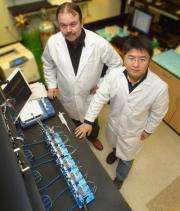Synthetic peptide may enhance lung transplantation

Lung transplant patients may one day benefit from a synthetic peptide that mimics the body's natural ability to reduce excess fluid accumulation, Medical College of Georgia researchers report.
Excess fluid and other problems that can occur within 72 hours of a transplant can dramatically reduce short-term survival odds and long-term lung function. About 10 percent of patients experience an acute lung injury in the hours after their transplant, killing more than 40 percent of those patients within 30 days.
MCG researchers show in the March issue of Critical Care Medicine that putting the TIP peptide into the trachea of rat lungs about a half hour before transplantation can nullify the bad result, called ischemic reperfusion injury, and improve oxygenation.
"We see the parameters of the transplanted lungs are nearly normal," said Dr. Rudolf Lucas, vascular biologist in MCG's Vascular Biology Center and the paper's corresponding author.
Reactive oxygen species are natural byproducts of oxygen use that can cause cell damage and death at high levels. Stress, such as putting dormant lungs back to work, can increase their levels. "Suddenly you put the lungs back in a body and you get an oxygen supply which by itself causes a lot of damage, mainly because of reactive oxygen species production," Dr. Lucas said, noting that donor lungs may be preserved in a cool, protective solution for several hours.
A major potential problem immediately after lung transplantation is dysfunction of sodium channels in the alveoli, tiny air sacs where oxygen uptake occurs, impairing the sacs' ability to clear fluid into the lymphatic system. Additionally, researchers have documented an immediate invasion of white blood cells called neutrophils, which also produce reactive oxygen species.
Implicated in these early problems is tumor necrosis factor, or TNF, an inflammation-producing cytokine that helps the body fight infection, which can be deleterious, even deadly, at high levels, Dr. Lucas said. The lung transplant activates TNF production, causing cells that line the organ's vasculature and air sacs to produce more reactive oxygen species and block sodium channels.
Interestingly, TNF can also have a polar opposite effect: blocking reactive oxygen species production and increasing sodium uptake. Dr. Lucas' team discovered this site, which binds to specific sugars, nearly a decade ago.
Unfortunately in the case of a lung transplant, the "bad" side is dominant; in fact, researchers from New Jersey Medical School refer to TNF's "Dr. Jekyll and Mr. Hyde saga" in an accompanying editorial in Critical Care Medicine.
That's where the synthetic TIP peptide comes in.
When scientists gave the synthetic peptide to rats undergoing lung transplants, the good side prevailed. Levels of reactive oxygen species and neutrophils dropped and sodium channels rebounded.
Soluble TNF receptors, which block TNF's "bad" action, already are being used to treat rheumatoid arthritis, in which the immune system attacks joints. MCG researchers have found that blocking this site does not block the positive-action, sugar-binding site. "That means we have a physiologically relevant form of this peptide in our body, a cytokine that could help us avoid the problems that lead to ischemic reperfusion injury," Dr. Lucas said. Next he will study whether that natural site can be revved up instead of giving a synthetic peptide. He also wants to explore the synthetic peptide's potential in diseases such as diabetes-associated vascular problems as well as with other types of organ transplants.
The synthetic peptide can act like a lectin, big proteins that bind to sugar. Just how this sugar-binding activates sodium uptake is something he's still studying. But he knows the sodium channel effect is important because when he blocks it, the positive effect of the synthetic peptide is lost.
He also wants to know the peptide's long-term impact, including its effect on neutrophils. If it continues to suppress their infiltration, the peptide also could have potential for chronic transplantation problems, including organ rejection, he said.
Collaborators for this study include Drs. Stephen Black and Sanjiv Kumar at the Vascular Biology Center, who helped with lung endothelial cell studies and measuring reactive oxygen species levels; Dr. Jürg Hamacher, pulmonologist and transplant surgeon at the University Hospital of Bern, Switzerland, who performed the lung transplants; and MCG postdoctoral fellow Dr, Guang Yang.
Three-year survival rates for lung transplants are about 64 percent and about 20,000 lung transplants have been done in the United States since the first successful single-lung transplant in 1983. Primary reasons for lung transplants include chronic obstructive pulmonary disease, pulmonary fibrosis, cystic fibrosis and lung cancer. As with most types of transplants, donors lungs are in short supply, so the mean wait time is about four years, which means many patients die waiting.















